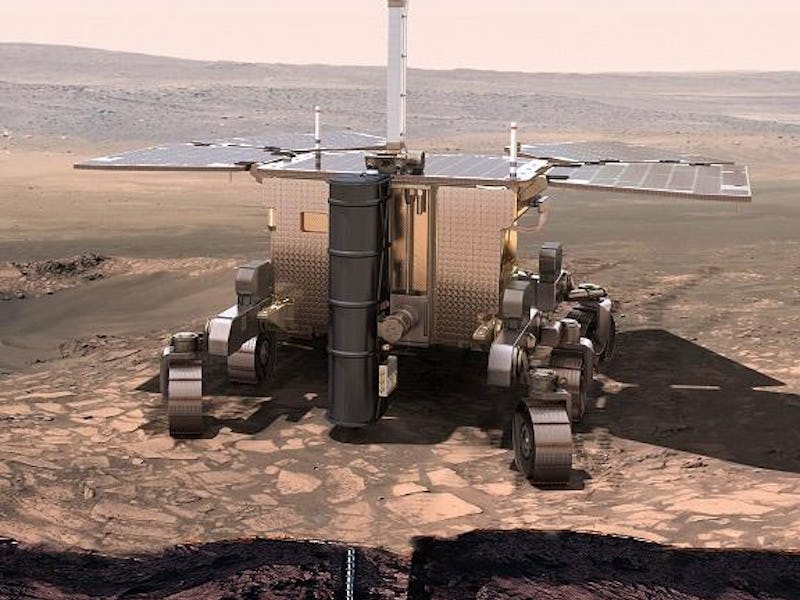Is there life beneath the Martian surface?
A rover may soon provide us with answers.

For years, scientists have searched long and hard for signs of life on the surface of Mars. And while there is evidence that the Red Planet may have at one point been a habitable world, no evidence of Martian life has been found.
However, what if life lurks beneath the surface? It may be hiding out in the Martian depths where water may abound.
A team of researchers from New York University in Abu Dhabi (NYU Abu Dhabi) is suggesting that conditions below the surface of Mars could have water and may possibly support life.
A study on the research was published Tuesday in the journal Scientific Reports.
The surface of Mars may be dry today, but it may have been flowing with water billions of years ago.
Although Mars is currently in its dry, desolate state, that wasn't always the case. Evidence suggests that throughout its 4.6 billion years of existence, Mars may have had polar ice caps, smooth canyons, and atmospheric vapors.
In September 2012, NASA announced that its Curiosity rover found evidence of an ancient stream bed in the Gale Crater on Mars, suggesting that water may have once flowed through it. However, over time, scientists believe that Mars lost its water through a process known as an atmospheric escape where particles escape from the planet's atmosphere and leak into outer space.
As a result, previous missions to Mars have not been able to find liquid water flowing on the surface of the planet. The subsurface, on the other hand, is yet to be explored.
The team of researchers behind the new study suggests that the subsurface of Mars may possibly support life since it has traces of water in the form of water-ice and brines. Additionally, the study also suggests that Galactic Cosmic Rays, high energy particles that bombard Earth and other planets, could be providing the energy for radiation-driven redox chemistry, or a type of chemical reaction where the states of atoms are changed, which could support life.
As a result, the study suggests that life may exist beneath the surface of Mars. However, it would have had to adapt to the harsh environment in the Martian subsurface that includes low temperatures and surface pressure, as well as a high dose of radiation.
"It is exciting to contemplate that life could survive in such a harsh environment, as few as two meters below the surface of Mars," Dimitra Atri, a research scientist at the Center for Space Science at NYU Abu Dhabi, and lead author of the new study, said in a statement.
Atri is betting on an upcoming mission to Mars to explore this possibility of life in the Martian subsurface.
The European Space Agency is launching ExoMars in the year 2022 in an effort to look for life, whether past or present, on Mars. The mission includes a rover that will roll across the Martian terrain, collecting samples with a drill and analyzing them with its host of instruments.The rover's drill is designed to extract samples from various depths, down to a maximum of two meters.
"When the Rosalind Franklin rover on board the ExoMars mission (ESA and Roscosmos), equipped with a subsurface drill, is launched in 2022, it will be well-suited to detect extant microbial life and hopefully provide some important insights," Atri said.
Abstract: There is growing evidence suggesting the presence of aqueous environment on ancient Mars, raising the question of the possibility of life in such an environment. Subsequently, with the erosion of the Martian atmosphere resulting in drastic changes in its climate, surface water disappeared, shrinking habitable spaces on the planet, with only a limited amount of water remaining near the surface in form of brines and water–ice deposits. Life, if it ever existed, would have had to adapt to harsh modern conditions, which includes low temperatures and surface pressure, and high radiation dose. Presently, there is no evidence of any biological activity on the planet’s surface, however, the subsurface environment, which is yet to be explored, is less harsh, has traces of water in form of water–ice and brines, and undergoes radiation-driven redox chemistry. I hypothesize that Galactic Cosmic Ray (GCR)-induced radiation-driven chemical disequilibrium can be used for metabolic energy by extant life, and host organisms using mechanisms seen in similar chemical and radiation environments on Earth. I propose a GCR-induced radiolytic zone, and discuss the prospects of finding such life with Rosalind Franklin rover of the ExoMars mission.
This article was originally published on